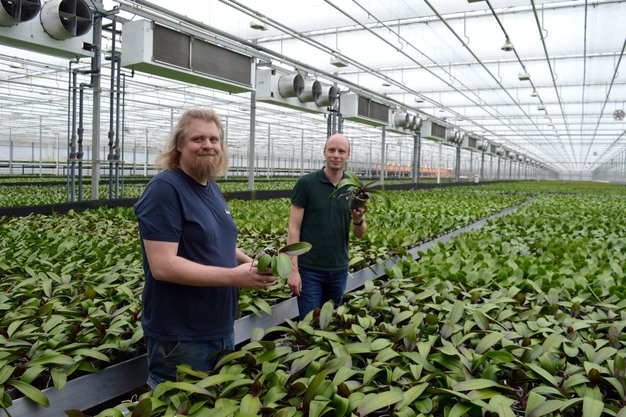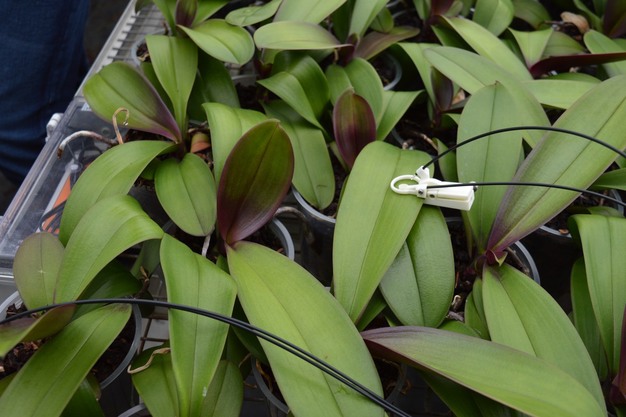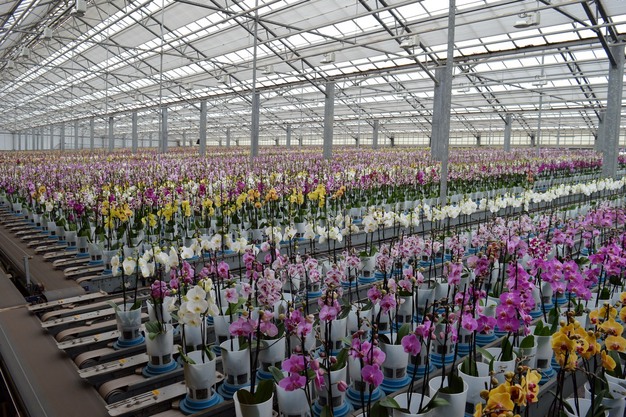In some respects, modern Dutch phalaenopsis growers function like a Tesla assembly line. Technology is everywhere, nothing is left to chance. Maarel Orchids is a clear example of this, Sendot, manufacturer of photosynthesis sensors, has been visiting them multiple times.
 Jeroen Wolkers and Johan Langelaan, Cultivation managers at Maarel Orchids
Jeroen Wolkers and Johan Langelaan, Cultivation managers at Maarel Orchids
We spoke to Jeroen Wolkers and Johan Langelaan (cultivation managers), and to Erwin Gräfe (account manager at Sendot, the nursery in Maasdijk the Netherlands). The men have a common goal: bringing autonomous cultivation one step closer. Towards this end, they focus on the well-being of the plant. Sendot's photosynthesis sensor can be used to determine the extent to which the available light is being used effectively, it also gives insight into the vitality of the plant.
Trend watchers
The picture below gives a clear idea of how this looks in practice. Glass fibres calculate which part of the light is effectively absorbed and how much light falls on the leaf. The glass fibres are clipped onto a leaf and emit a small light pulse every fifteen minutes. The sensors are placed at various positions in the company. For the greenhouse, that covers about 9 hectares of cultivation area, 8 sensors are being used (that is, two sensors per department). These sensors function as 'trend watchers', the growers say. They can never make definitive or general statements; you are dealing with different varieties and varying plant activity per department (hot vs. cold). However, it does say something about the extent to which the plant is thriving, whether it needs some extra help or whether the lamp should be dimmed.

The photosynthesis sensor in operation
Theoretically, the computer can control this, especially because it is also provided with information from the PAR meter. However, that is not happening (yet), for reasons that are contained in the word trend watcher. The second step is using obtained data to optimize and adjust processes, which is already the case here. The third step is controlling the input automatically. "We want to create operational sensors that matter. In other words, we don't intend to remain at this first level. The sensors must be easy to work with both in the field and the greenhouse. Moreover, they must have a good price /quality ratio.
Development
Over the course of time, the sensors have been considerably developed. The first examples were handheld loggers, their stored data could be read by means of software. Later on, a wired live monitoring system was introduced. However, this system was not convenient as it has to function in a constantly changing environment. Take for instance phalaenopsis cultivation. Then a wireless version followed, which made it a lot more convenient. Links with the climate computer were also developed. These innovations have ensured that the current sensors reached the second 'process level'. Currently, they need to find out to which extent cultivation can be outsourced to a computer, and which product innovations are needed. These are issues that Sendot is happy to answer in close consultation with growers.
 The plant buffer
The plant buffer
Gaining insight
Sendot is widely used in floriculture and there is a lot of interest in the photosynthesis sensor, especially from orchids. Their cultivation is long and intensive, and involves specific cultivation techniques. Moreover, the results of a previous disruption in the process tends to be visible months later.. "That's why we have to know what that light does," says Jeroen, "especially because the control options have increased enormously in recent years. Previously, we turned the Son-t off, or we put it on half power. Now we have LED. In combination with the screens we can control and dose the light quite precisely."
"With sensors you gain insight into real-time data," Erwin adds . "This applies to photosynthesis, but also to sensors that provide insight into oxygen, humidity and temperature in the root environment. They provide us with a better understanding of the functioning of the crops. Analyzing and using this data will allow for the further optimization of cultivation practices. It will not only improve the yield and the quality of the crops, but it will also minimize the input of resources such as water, fertilizers and energy. Eventually, this will pave the way for autonomous cultivation. " Jeroen states: "At Maarel we started in a similar way."
For more information: Sendot
Sendot
[email protected]
www.sendot.nl
Maarel Orchids
[email protected]
www.maarelorchids.nl

